
The United Kingdom Infra-Red Telescope (UKIRT) is a 3.8 metre (150 inch) infrared reflecting telescope, the second largest dedicated infrared telescope in the world. It is located on Mauna Kea, Hawai'i as part of Mauna Kea Observatory. Until 2014 it was operated by the Joint Astronomy Centre in Hilo. It was owned by the United Kingdom Science and Technology Facilities Council. UKIRT is currently being funded by NASA and operated under scientific cooperation between Lockheed Martin Advanced Technology Center, the University of Hawaii, and the U. S. Naval Observatory. The telescope is set to be decommissioned after completion of the Thirty Meter Telescope as part of the Mauna Kea Comprehensive Management Plan.

The Mauna Kea Observatories (MKO) are a number of independent astronomical research facilities and large telescope observatories that are located at the summit of Mauna Kea on the Big Island of Hawaiʻi, United States. The facilities are located in a 525-acre (212 ha) special land use zone known as the "Astronomy Precinct", which is located within the 11,228-acre (4,544 ha) Mauna Kea Science Reserve. The Astronomy Precinct was established in 1967 and is located on land protected by the Historical Preservation Act for its significance to Hawaiian culture. The presence and continued construction of telescopes is highly controversial due to Mauna Kea's centrality in native Hawaiian religion and culture, as well as for a variety of environmental reasons.

The Particle Physics and Astronomy Research Council (PPARC) was one of a number of research councils in the United Kingdom. It directed, coordinated and funded research in particle physics and astronomy for the people of the UK. Its head office was at Polaris House in Swindon, Wiltshire, but it also operated three scientific sites: the UK Astronomy Technology Centre in Edinburgh, the Isaac Newton Group of Telescopes (ING) in La Palma and the Joint Astronomy Centre (JAC) in Hawaii. It published the Frontiers magazine three times a year, containing news and highlights of the research and outreach programmes it supports.

The Atacama Large Millimeter/submillimeter Array (ALMA) is an astronomical interferometer of 66 radio telescopes in the Atacama Desert of northern Chile, which observe electromagnetic radiation at millimeter and submillimeter wavelengths. The array has been constructed on the 5,000 m (16,000 ft) elevation Chajnantor plateau - near the Llano de Chajnantor Observatory and the Atacama Pathfinder Experiment. This location was chosen for its high elevation and low humidity, factors which are crucial to reduce noise and decrease signal attenuation due to Earth's atmosphere. ALMA is expected to provide insight on star birth during the early Stelliferous era and detailed imaging of local star and planet formation.
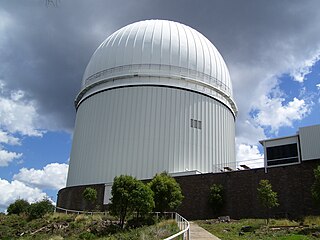
The Australian Astronomical Observatory (AAO), formerly the Anglo-Australian Observatory, was an optical and near-infrared astronomy observatory with its headquarters in North Ryde in suburban Sydney, Australia. Originally funded jointly by the United Kingdom and Australian governments, it was managed wholly by Australia's Department of Industry, Innovation, Science, Research and Tertiary Education. The AAO operated the 3.9-metre Anglo-Australian Telescope (AAT) and 1.2-metre UK Schmidt Telescope (UKST) at Siding Spring Observatory, located near the town of Coonabarabran, Australia.
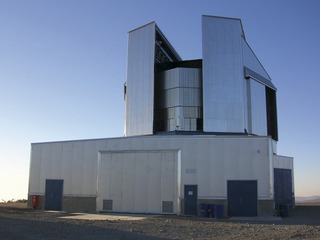
The VISTA is a wide-field reflecting telescope with a 4.1 metre mirror, located at the Paranal Observatory in Chile. It is operated by the European Southern Observatory and started science operations in December 2009. VISTA was conceived and developed by a consortium of universities in the United Kingdom led by Queen Mary University of London and became an in-kind contribution to ESO as part of the UK's accession agreement, with the subscription paid by the UK Science and Technology Facilities Council (STFC).

The Canada–France–Hawaii Telescope (CFHT) is located near the summit of Mauna Kea mountain on Hawaii's Big Island at an altitude of 4,204 meters, part of the Mauna Kea Observatory. Operational since 1979, the telescope is a Prime Focus/Cassegrain configuration with a usable aperture diameter of 3.58 metres (11.7 ft).
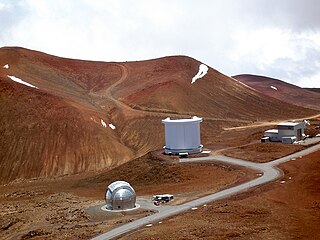
The James Clerk Maxwell Telescope (JCMT) is a submillimetre-wavelength radio telescope at Mauna Kea Observatory in Hawaii, US. The telescope is near the summit of Mauna Kea at 13,425 feet (4,092 m). Its primary mirror is 15 metres across: it is the largest single-dish telescope that operates in submillimetre wavelengths of the electromagnetic spectrum. Scientists use it to study the Solar System, interstellar dust and gas, and distant galaxies.
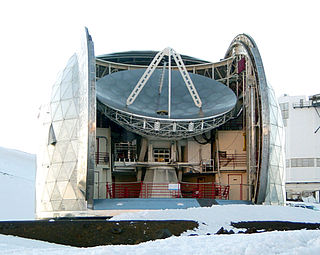
The Caltech Submillimeter Observatory (CSO) was a 10.4-meter (34 ft) diameter submillimeter wavelength telescope situated alongside the 15-meter (49 ft) James Clerk Maxwell Telescope (JCMT) at Mauna Kea Observatories. It was engaged in submillimeter astronomy, of the terahertz radiation band. The telescope closed on September 18, 2015. As of April 2019, the telescope is set to be dismantled and its site remediated in the near future as part of the Mauna Kea Comprehensive Management Plan.

The Haleakalā Observatory, also known as the Haleakalā High Altitude Observatory Site, is Hawaii's first astronomical research observatory. It is located on the island of Maui and is owned by the Institute for Astronomy of the University of Hawai'i, which operates some of the facilities on the site and leases portions to other organizations. Tenants include the Air Force Research Laboratory (AFRL) and the Las Cumbres Observatory Global Telescope Network (LCOGTN). At over 3,050 meters (10,010 ft) in altitude, the summit of Haleakalā is above one third of the Earths's troposphere and has excellent astronomical seeing conditions.

The Kölner Observatorium für SubMillimeter Astronomie (KOSMA) was a radio telescope for submillimeter astronomy located at 3,135 m (10,285 ft) on Gornergrat near Zermatt (Switzerland). It was operated by I. Physikalisches Institut, University of Cologne, and Radioastronomisches Institut, University of Bonn.

Submillimetre astronomy or submillimeter astronomy is the branch of observational astronomy that is conducted at submillimetre wavelengths of the electromagnetic spectrum. Astronomers place the submillimetre waveband between the far-infrared and microwave wavebands, typically taken to be between a few hundred micrometres and a millimetre. It is still common in submillimetre astronomy to quote wavelengths in 'microns', the old name for micrometre.
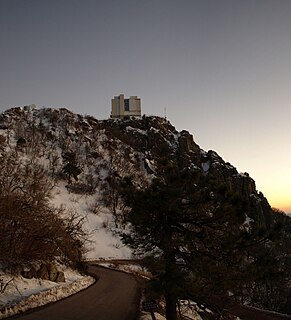
The MMT Observatory (MMTO) is an astronomical observatory on the site of Fred Lawrence Whipple Observatory. The Whipple observatory complex is located on Mount Hopkins, Arizona, US in the Santa Rita Mountains. The observatory is operated by the University of Arizona and the Smithsonian Institution, and has a visitor center in nearby Amado, Arizona. The MMTO is the home of the MMT, which has a primary mirror 6.5 m in diameter. The name comes from the six smaller mirrors originally used before the single primary mirror was installed in 1998. The primary mirror has a special lightweight honeycomb design made by the University of Arizona's Steward Observatory Mirror Laboratory. The MMT is housed in a building which allows the walls and roof around the telescope to be completely rolled back, allowing it to cool down very quickly in order to improve observation.

The Starlink Project, referred to by users as Starlink and by developers as simply The Project, was a UK astronomical computing project which supplied general-purpose data reduction software. Until the late 1990s, it also supplied computing hardware and system administration personnel to UK astronomical institutes. In the former respect, it was analogous to the US IRAF project.

The Royal Observatory, Edinburgh (ROE) is an astronomical institution located on Blackford Hill in Edinburgh. The site is owned by the Science and Technology Facilities Council (STFC). The ROE comprises the UK Astronomy Technology Centre (UK ATC) of STFC, the Institute for Astronomy of the School of Physics and Astronomy of the University of Edinburgh, and the ROE Visitor Centre.

The Dominion Radio Astrophysical Observatory is a research facility founded in 1960 and located at Kaleden, British Columbia, Canada. The site houses four radio telescopes: an interferometric radio telescope, a 26-m single-dish antenna, a solar flux monitor, and the Canadian Hydrogen Intensity Mapping Experiment (CHIME) — as well as support engineering laboratories. The DRAO is operated by the Herzberg Institute of Astrophysics of the National Research Council of the Government of Canada. The observatory was named an IEEE Milestone for first radio astronomical observations using VLBI.

The NRC Herzberg Astronomy and Astrophysics Research Centre, formerly the NRC Herzberg Institute of Astrophysics (NRC-HIA), is the leading Canadian centre for astronomy and astrophysics.
The UK Astronomy Technology Centre is based at the Royal Observatory in Edinburgh, Scotland, and is part of the Science and Technology Facilities Council.
Two instruments known as the Submillimetre Common-User Bolometer Array, or SCUBA, have been used for detecting submillimetre radiation on the James Clerk Maxwell Telescope in Hawaii.


















